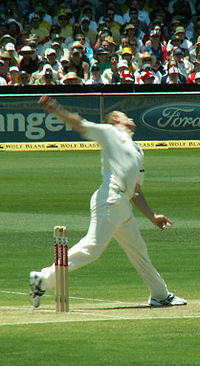Bowling and dismissals
Bowling

A bowler delivers the ball toward the batsmen, using what is known as a bowling action: the elbow may be held at any angle and may bend further, but may not straighten out during the action. If the elbow straightens, it is an illegal throw and the delivery is called a no-ball. Under new cricketing law, after consultation with health experts, the bowler is allowed to straighten his arm 15 degrees or less; if the bowler straightens his arm more than 15 degrees it is called a "no ball".
Usually, the bowler pitches the ball so that it bounces before reaching the batsman. Some part of the bowler's front foot in the delivery stride (that is, the stride when the ball is released) must be behind the popping crease to avoid a no-ball (although the bowler's front foot does not have to be grounded). The ball must also be delivered so it is within the batsman's reach; otherwise it is termed a wide. A wide cannot be called if the batsman hits the ball. A wide or no-ball results in an extra run being added to the batting team's score and an extra ball being bowled in the over.
The bowler's primary goal is to take wickets; that is, to get a batsman out or dismissed. When a bowler succeeds in dismissing the more accomplished batsmen on the opposing team he reduces the opportunity for the batting team to score, as it exposes the less skillful non-specialist batsmen. The bowler's secondary task is to limit the numbers of runs scored. There are two main kinds of bowlers: pace bowlers, who attempt to bowl the ball too quickly for the batsman to properly react, and spin bowlers who bowl slower deliveries that bounce and curve in unpredictable ways.

No comments:
Post a Comment